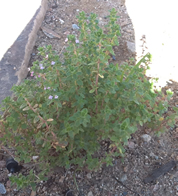Scientific genus: Thymus
Common name: Thyme
Plant family: Lamiaceae
Written by Zachary Sippel, 8th Grade Intern
The summer of 2013 brought many changes to the Santa Fe Botanical Garden, including the inaugural year of our youth Internship Program. Kate Gale and Zachary Sippel, middle school students, volunteered eight hours a week from June through early August. They tackled many projects, including creating a smartphone scavenger hunt and working with the Garden Sprouts toddlers. They were a welcome addition to our organization, and we hope to see them both again next summer. Zachary, a budding botanist and cook, also volunteered to write the Plant of the Month Article for this Clippings. Enjoy!
The ancient Romans spread thyme throughout Europe. As they conquered new lands, they brought it with them from the Mediterranean. They used it as an ingredient in cheeses and liqueurs. Then, in European Middle Ages, thyme was used to give warriors courage on the battlefield. The Europeans would also leave thyme under their pillows, believing that it would give a deep and restful sleep. Meanwhile, the Greeks would burn thyme in their temples as incense, and use it as an ingredient in their baths. The ancient Egyptians also used thyme for embalming the dead. In the Renaissance “to smell as sweet as thyme” was a common compliment. The Italians grazed sheep and goats on thyme for the flavor it gave the meat. Thyme is thought to be beneficial to the lungs, and it is used as an ingredient in cough medicine today.
Thyme grows best in hot sunny places. It likes has soil that won’t flood and will tolerate alkaline conditions. Thymes also prefer soil with moderate fertility. In the Botanical Garden at Museum Hill, several varieties of thyme grow as ground covers and as a part of the perennial boarder in the Orchard. Thyme flowers range in color from white through a deep magenta. It tends to bloom in the spring and summer with small delicate flowers. Thyme should have woody growth pruned after the last frost in the spring. This is a favorite plant in Santa Fe Gardens due to the hardiness of the little plant. It can be found either as a small shrub or as a creeping groundcover. Both offer a beautiful addition to your perennial or herb beds.
Thyme, if used carefully, will add a delicious fragrance to the simplest of salads and soups, and it is a favored ingredient by cooks around the world.
A FAVORITE RECIPE WITH THYME BORROWED FROM HERBS IN THE KITCHEN, by C. Dille and S. Belsinger
Mushrooms with Thyme on Toast
- 1/2 ounce dried porcini mushrooms
- 1 cup boiling water
- 8 slices of bread about 3 inch across and 1/2 inch thick
- 2 garlic cloves
- 1/2 pound cultivated mushrooms
- 2 tablespoons butter
- 1 tablespoon olive oil
- 6 thyme sprigs
- 1 tablespoon dry sherry
- Salt and freshly ground pepper
- 1 tablespoon minced parsley
Pour boiling water over the porcini and let stand for 30 minutes. Lightly toast the bread and allow to cool. Rub each piece of bread lightly on both sides with one of the garlic cloves. Place them on a serving dish. If the cultivated mushrooms are large halve them and slice thin. If they are small slice them thin. Trim the porcini and rinse carefully to rid them of any sand. Strain the liquor through a sieve lined with a damp paper towel or fine weave cheese cloth and reserve it. Chop the porcini coarsely. Heat the butter and oil in a sauté pan over medium heat. Added the sliced mushrooms to the pan and cook for about a minute. Add the porcini. Press the remaining clove of garlic into the pan and stir well. Add the thyme about 1/3 cup of the reserved mushroom liquor and the sherry and stir well. Cook, stirring occasionally for 3 to 5 minutes until most of the liquid has been absorbed. Season with salt and pepper. Take the pan off the heat and remove the thyme sprigs hold them hold them one at a time and move your fingers down the sprigs. Stir the leaves that come off into the mushrooms. Divide the mushrooms and evenly over the prepared toast. Garnish with parsley and serve immediately.
Species list of thymes in the Orchard Gardens:
Thymus x citriodorus, Lemon Thyme
Thymus neiceffii, Juniper-leaved Thyme
Thymus pseudolanuginosis, Wooly Thyme
Thymus serpyllum ‘Pink Chintz’ , Wild Thyme ‘Pink Chintz’
Thymus serpyllum ‘Victor Reiter’, Wild Thyme ‘Victor Reiter’
Thymus vulgaris, English Thyme



